The rough with the smooth: a closer look at the potential work of a master sculptor
Wrong or right. True or false. Fake or fortune. It is around these comfy binaries that confident judgements are often made, shored against the seemingly solid structures of certainty and authority. But the foundations of these assertions often rest on shifting sands of time and tastes, threatened by the ebb and flow of stranger tides: dark seas of new discoveries, hidden depths, and unknown unknowns. Which is all perhaps a very roundabout way of saying: the Modants studio is lucky enough to have a wonderfully enticing piece on its hands, deserving of thorough investigation.
The Viennese literary modernist Stefan Zweig, a wildly popular littérateur in his day but now largely consigned to the dustier shelves of English faculty libraries, once wrote that “nothing whets the intelligence more than a passionate suspicion, nothing develops all the faculties of the mind more than a trail running away into the dark”. Zweig was referring to an altogether different kind mystery in his novella The Burning Secret, but what an artistic trail we have here—one that encourages the viewer to keep on running. A plaster cast sculpture of a man on horseback, exquisitely rendered and replete with certain signs and subtleties that arguably reveal the work of a master sculptor: Emile-Antoine Bourdelle.
+ Bourdelle: a background
Often said to be the most French of the master sculptors of the Paris School, thanks to his vocation as a true builder, his humanism, and his spirit of order and geometry, Bourdelle is one of the most important sculptors of the 20th century. His highly sought after work is dotted across galleries around the world, and pieces regularly sell for hundreds of thousands.
Born in 1861 in the southern French medieval town of Montauban, the birthplace of the great Neoclassical painter Ingres, Bourdelle was the son of a carpenter and cabinetmaker. He joined his father’s studio as an apprentice when was he was 13, and learned the fundamentals of woodwork and craftsmanship. His first wood carvings were of such promise that later, at the age of only 15, he won a scholarship to study at the École des Beaux-Arts in Toulouse, where he studied under the sculptor Henri Maurette. At the age of 24 he won a scholarship to the École des Beaux-Arts in Paris, leaving le sud for the capital and the seemingly endless possibilities of life that seem to abound there.
In Paris, he enjoyed early success at the ‘Salon des Artistes Français’ in 1885 and the ‘Exposition Universelle’ in 1889. Following further studies, he then worked with Jules Dalou and later as an assistant to Auguste Rodin, the “Michelangelo of France,” between 1893 and 1908.
Bourdelle initially became part of the iconic sculptor’s studio when Rodin hired him as a "praticien" (sculptor's assistant); his specific role was as a ‘fine hewer’. To be clear, Rodin did not actually carve any of his marbles; instead he would hire specialists to do the carving. Usually, two types of carvers worked on a marble: first, the rough hewer, who would perform the more crude shaping of the block in its initial stages; second would be the fine hewer who would execute the intricate modelling and finish the surface. Antony Gormley claims that modern sculpture all begins with Rodin. If that’s the case, and I’m inclined to believe that it is, then Bourdelle was there, in the beginning. He interpreted and executed the vision of the father of modern sculpture.
Not only this, but Bourdelle's role in Rodin’s studio places him in the artistic bazaar of early 20th century Paris, right at the beating heart of European artistic innovation. Paris at the turn of the century was a breath-taking fusion of respect and admiration for the old, and daring experimentation with and excitement about the new. Rodin’s circle was practically a never ending carousel of the European intelligentsia, from Rainer Maria Rilke to W.B. Yeats, Stéphane Mallarmé, and the aforementioned Stefan Zweig. One wonders what they were putting into the water in Paris a century or so ago to produce people with such a capacity to enter into the human condition, and then render it into art or analysis. These avant-garde artist were the first to explore new spheres of expression: in their own way, they were the Scotts and Amundsens of fin-de-siècle art—the first to plant a flag at the outer extremes of artistic and intellectual possibility.
It was in these cultural waters that Bourdelle swam. But eventually he also had to escape what Roger Fry called Rodin’s ‘dominating genius’. After all, nothing grows under such big trees. Bourdelle built on the drama and realism of Rodin's style, his sculpture moving away slightly from the sensual, light-catching modelling of his old teacher to a more overtly heroic and monumental conception of the figure. This conception is visible in Bourdelle’s Héraklès archer, executed in 1909 and first exhibited in the Salon of 1910. The work established his reputation, and is often considered to be the sculptor’s masterpiece. The first cast of the monumental version was purchased by Prince Eugene of Sweden for his palace in Stockholm, and a gorgeous bronze version is on view at The Met. Other major works include The Dying Centaur, the statue of France Saluting America, and the monument to Adam Mickiewicz.
As Bourdelle’s career progressed, he taught Giacometti and Henri Matisse, became a commander of the Legion of Honor in 1924, and lived out his days in his studio, which is now a dedicated museum. Today, at 18 rue Antoine Bourdelle, the Musée Antoine Bourdelle sits amidst brick houses in a small, rather innocuous, street between the Gare Montparnasse and the offices of the famous French newspaper Le Monde.
THE WORK
The piece itself is intensely provocative. On a textured, gently sloping base, a horse stands, head bowed, hind legs taut, and mounted by a formidable figure in ceremonial military garb. As the horse leans forward, its rider leans back, cape flowing behind him: the figure’s pose, with his left hand on the reins and his shoulders pushed back, is triumphant. The sculpture is rhythmic, dynamic, and exceptionally executed. Significantly, the work also seems to subscribe to certain conventions of formal portraits of important men.
So what does it mean? Why does it mean anything at all? This question works on a number of levels. On the abstract level of the sculptural object, it is useful, as ever, to turn to John Berger: “Compare a sculpture with a tree in winter. Because a tree grows, its forms are changeable and this is implicit in their shapes and configuration. As a result its relation to the surrounding space appears to be an adaptive one." Berger then compares a sculpture with a building and a machine. Having done that, he is ready to specify the way a sculpture "appears to be totally opposed to the space that surrounds it”: its “frontiers with that space are definitive. Its only function is to use space in such a way that it confers meaning upon it. It does not move or become relative. In every way possible it emphasises its own finiteness. And by so doing it invokes the notion of infinity and challenges it. We, perceiving this total opposition between the sculpture and the surrounding space, translate its promise into terms of time. It will stand against time as it stands against space."
On the level of this specific piece, there are a number of ways in which the sculpture stands the test of time. Primarily, it bears a striking resemblance to Bourdelle’s monument to General Alvear, an immense public work in Buenos Aires. General Carlos Maria de Alvear was the hero of the Argentine liberation movement, and following the celebration of the centennial of Argentine independence from Spain in 1910, Bourdelle was officially commissioned to produce a commemorative monument in 1913. This echoed previous Argentine commissions for French sculptors: Buenos Aires’ first monument, an equestrian statue of another independence-era hero, General Jose de San Martin, was created by the Frenchman Louis Joseph Daumas in 1862. More followed, such as Carrier-Belleuse’s work of Manuel Belgrano on horseback, as well as a sculpture of Sarmiento, executed by Rodin and inaugurated in 1900.
The Monumento ecuestre a Carlos María de Alvear located on Plaza Julio de Caro, a landmark in the Recoleta neighbourhood of Buenos Aires.
The nature of Franco-Argentine relations in the early twentieth century diverged from the metropole-colony dynamic of the empire, and there were complex cultural ties between the two countries. Paris was the perceived capital of the civilised world, and Argentine appropriation of French ideas and fasts stemmed from a homegrown desire on the part of Argentinian elites to adopt cultural forms, from political ideologies to art, that were internationally associated with ‘civilisation’ and modernity. The urban landscape of Buenos Aires was remade in the image of the French capital, with wide, tree-lined boulevards and sprawling public plazas. Statues were equally important in the formation of a new national identity: literal territorial markers of the state. Such monuments were tangible symbols of Argentina’s arrival as a legitimate young Latin American republic. Indeed, Argentina welcomed many French migrants during this period—around 250,000 people between 1880 and 1910. Today, up to 17% of Argentines have partial French ancestry, with famous examples including First Lady Eva Peron, rugby player Agustín Pichot, and footballer Gonzalo Higuain—who, in fairness, does look as if he knows his way around the boulangerie.
Returning to our plaster, the piece has undeniable similarities with the monument to Alvear in the Argentinian capital. In subject, style, form, and structure, the two sculptures are clearly closely related: the distinguished, dominating pose of the rider; the impressive musculature of the horse; the billowing cape, to name just a few of the countless similarities.
Of course, there are some differences too, most notably in size and material: the sixteen foot bronze standing to attention on Plaza Julio de Caro is naturally on a contrasting scale to the two and half foot high plaster in the Modants studio. On a more granular level, the general has his right hand in the air, as opposed to by his side, and the animal is represented with its foreleg tucked up against its body and its head up. But once Bourdelle’s process is understood, these differences make perfect sense.
THE PROCESS
Bourdelle was commissioned to produce the monument in 1913, but it was not inaugurated until 1926, thirteen long years later. The project was interrupted by the First World War, which resulted in a shortage of materials and labour. However, the delay also gave Bourdelle a wealth of time to prepare for this major work; in fact, the unusually lengthy creative process lends weight to the compelling possibility that the sculptor completed a number of models and studies as part of that preparation. That he made such studies is not in doubt: the Musée Ingres-Bourdelle, in Bourdelle’s birthplace, houses two equestrian maquettes of unquestionable similarity to the plaster we have on our hands, and attributed to the master sculptor.
The two pieces, both in plaster, each resemble the monument to General Alvear and, crucially, also display various differences. Like our work, they are not the finished article, but demonstrate aspects of Bourdelle’s artistic experimentation on his way to the ultimate goal. Upon immediate comparison, they share the ceremonial ambience of our work: the imposing military figure, the magnificent muscular tension of the horse, the finely worked plaster bearing the marks of its maker.
There are also divergences: the horse’s head is at differing levels in the two maquettes, from fully bowed to a shallower arch, while the animal’s legs are in contrasting positions to both the final piece and our plaster.
The key takeaway, though, is that Bourdelle’s work exists on a continuum—a succession of drafts, impressions, workings and reworkings. His sculpture does not appear out of nowhere, but rather gradually takes form, with the sculptor tweaking and honing until the final form emerges. He is known to have worked on multiple models for his major works, such as the monument to General Alvear.
Two maquettes for the Alvear monument, c. 1913, on display at the Musée Ingres-Bourdelle, Montauban.
The finished bronze, inaugurated in Buenos Aires in 1926.
A final plaster model for the bronze casting of the Alvear monument, on display at the Musée Bourdelle in Paris.
The materiality of our piece is also suggestive of Bourdelle’s influence. The material is all-important in sculpture—affecting how light and shadow play across the surface, and furthering the ambition of the design. Our model is plaster, worked on a metal frame. In many ways, it is the perfect example of the rough surfaces of Bourdelle's sculptures so influenced by Rodin, and his use of flat, simplified forms drawn from archaic Greek and Roman antiquity.
While marble is widely considered the highest quality of media, plaster provides more opportunities for exploration with its easier handling of additive and subtractive methods of sculpture. Indeed, it was Rodin’s favourite medium to work with. In this case, the piece is branded with marks that tell of their rites of passage during Bourdelle’s modelling stage. All sculptures operate between image and object, between representation and materiality. But our work gives us an insight at the level of practice and making. The replicatory and recombinatory potential of plaster casting in developing the figures of horse and rider is ideal for this stage of the project. Marks of the chisel or the thumb are still visible—traces of the sculptor’s process and manipulation.
The model thus bears the evidence of having been hand-made, as Bourdelle’s gouges, marks, and finger impressions give us a real sense of immediacy. The sculptor is almost physically present, having touched the object in a way that is visible and recoverable on the surface of the sculpture. Compared to the final bronze, our work is more physical, more material, and a closer record of the scene of creation. It is a portal into Bourdelle’s creative world.
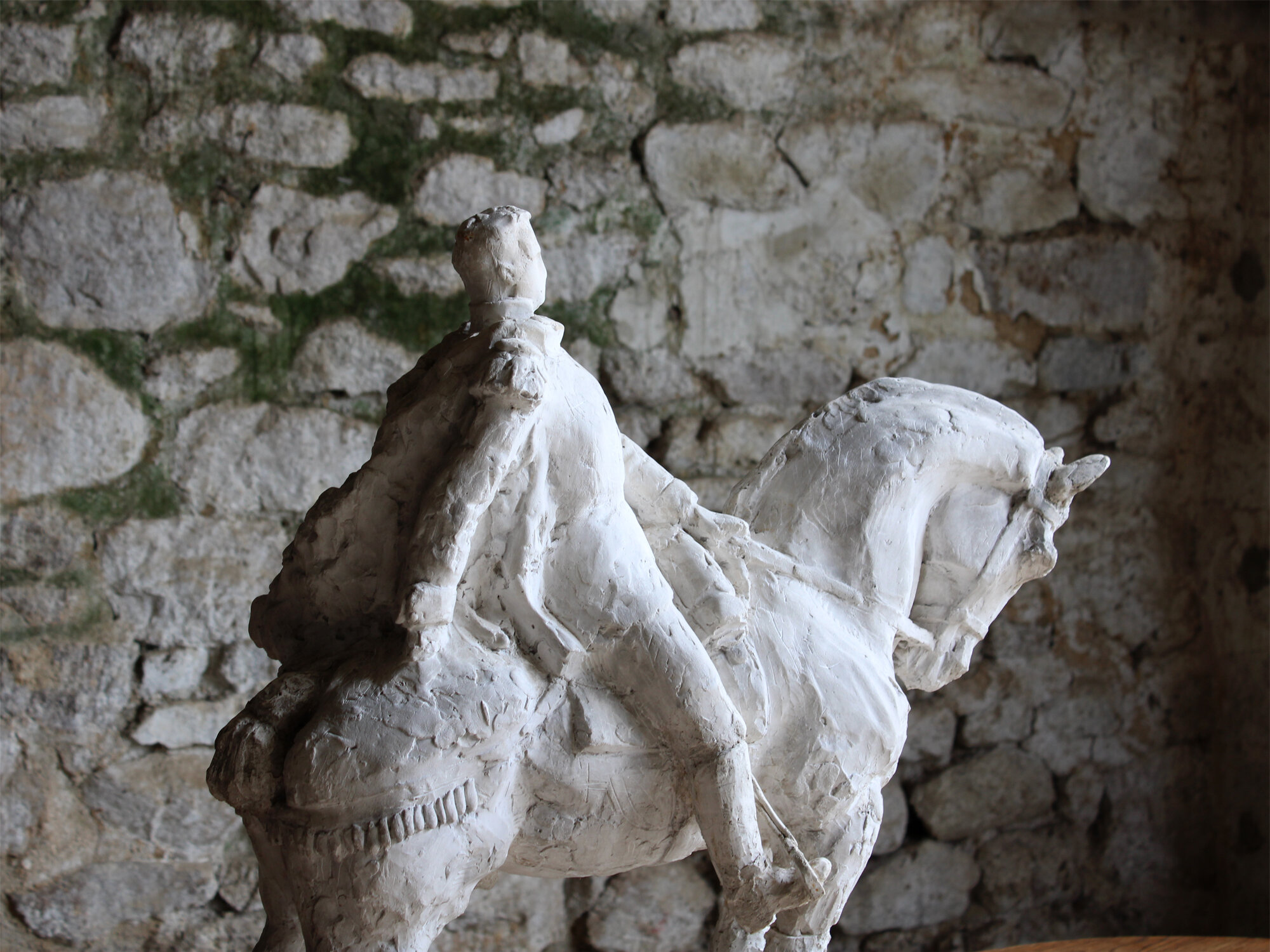
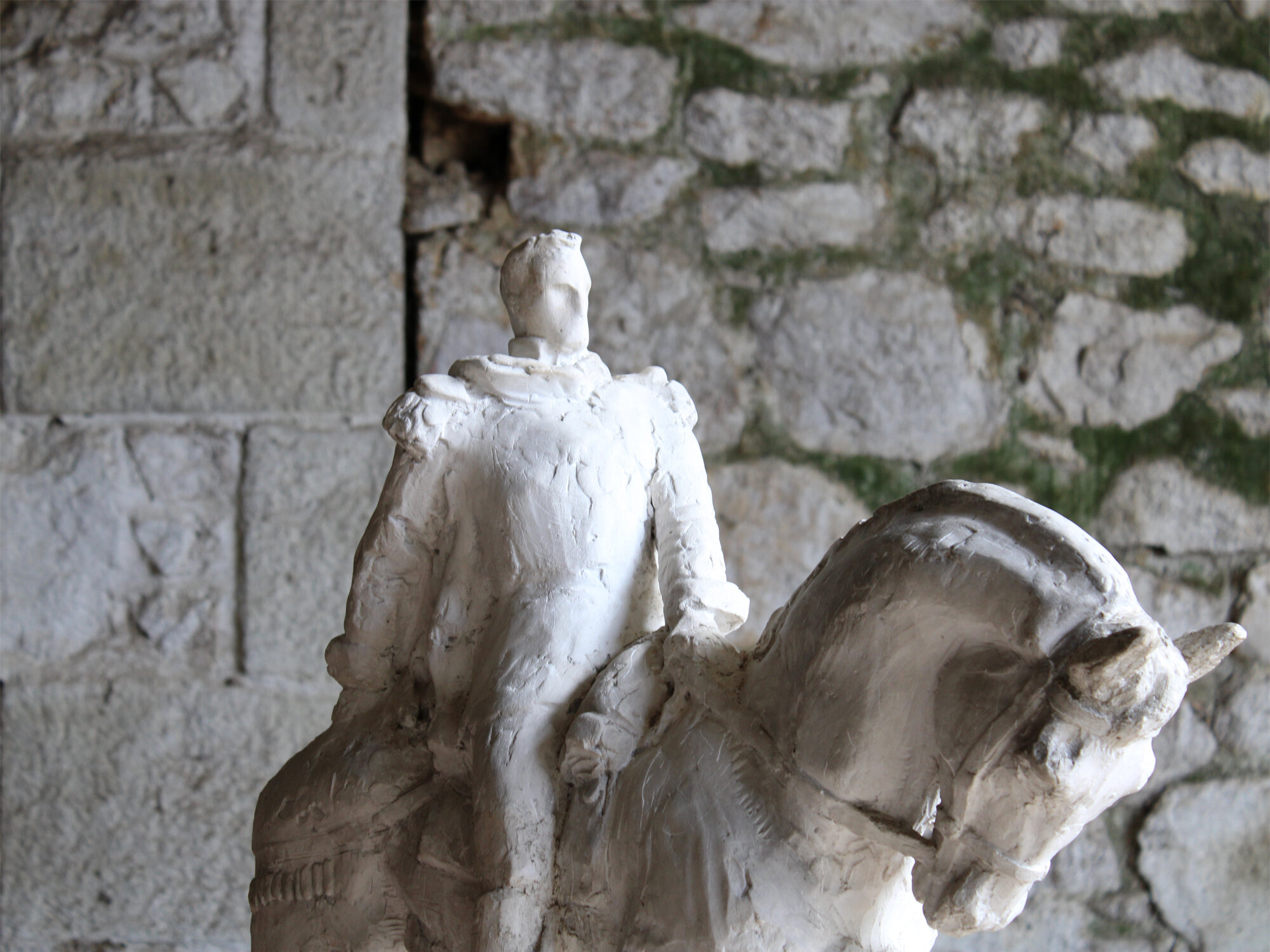
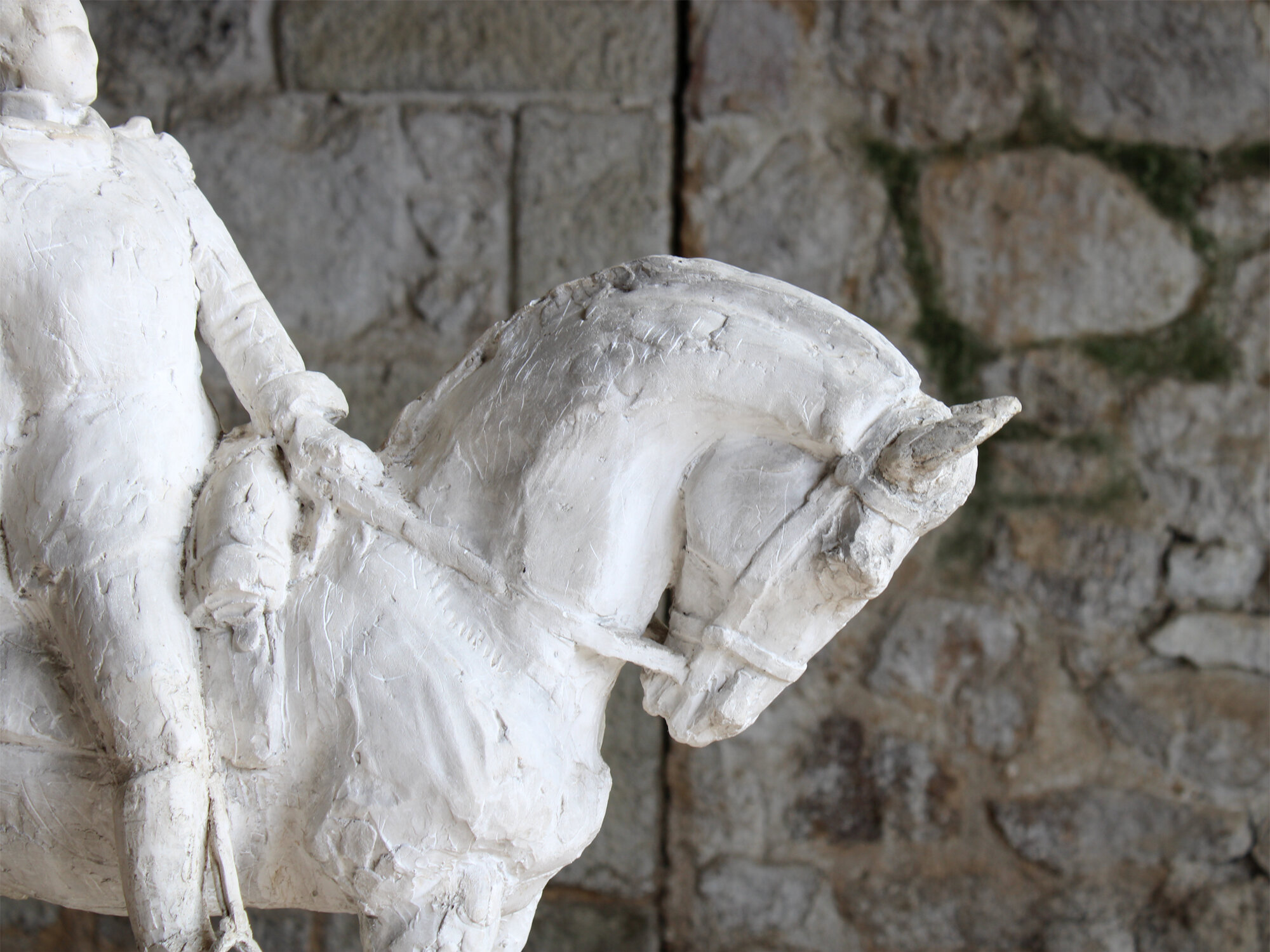
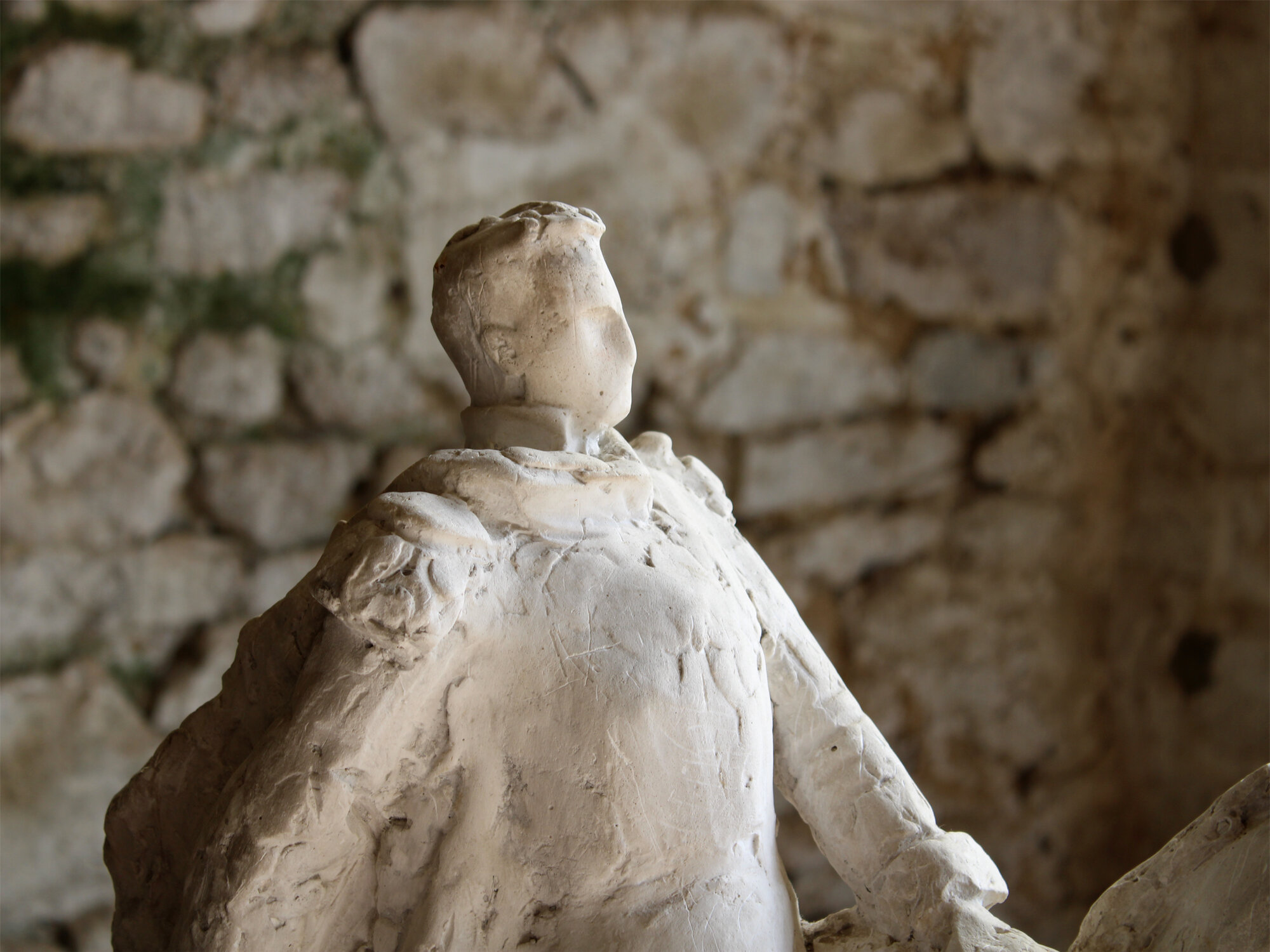
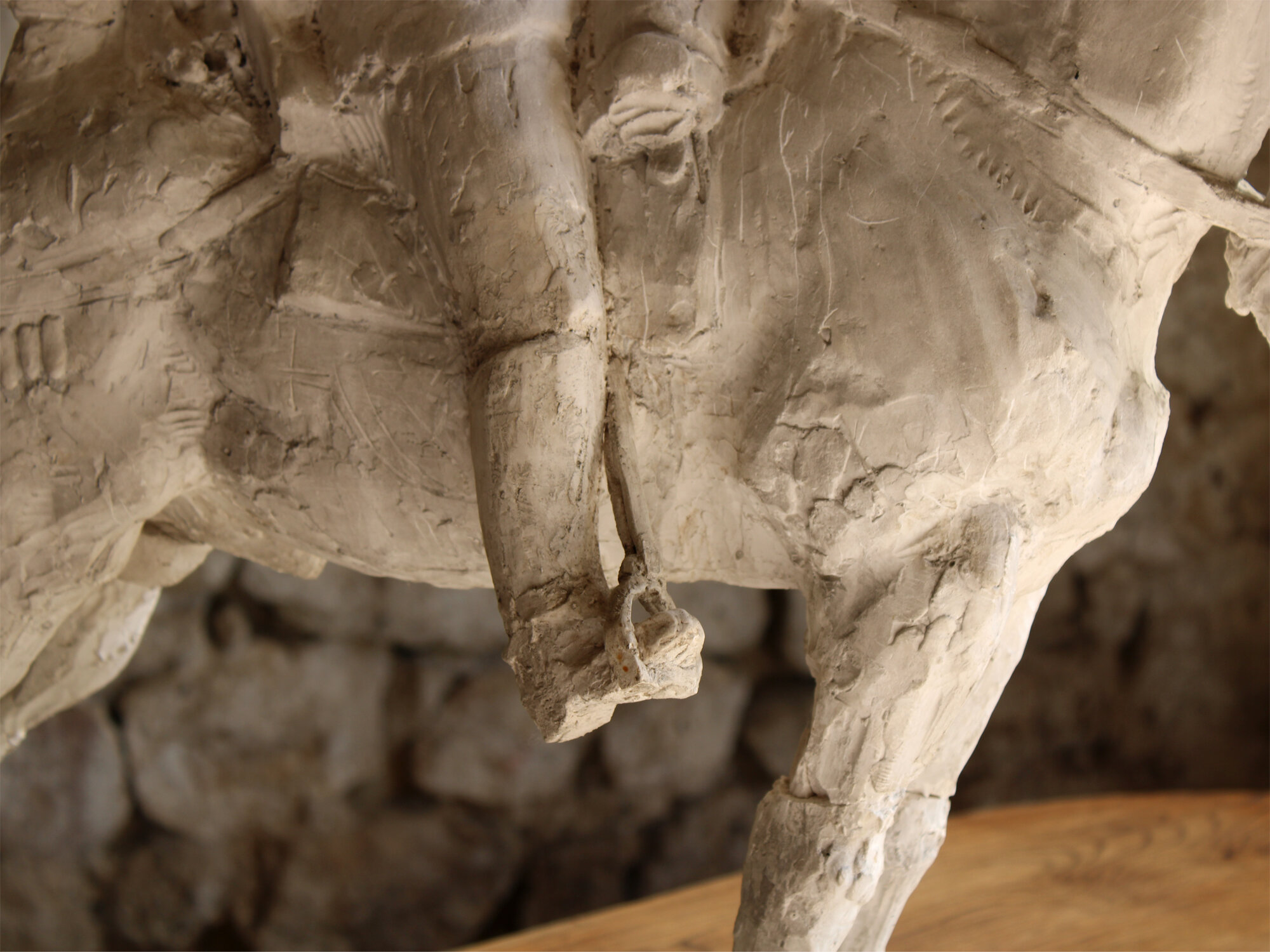
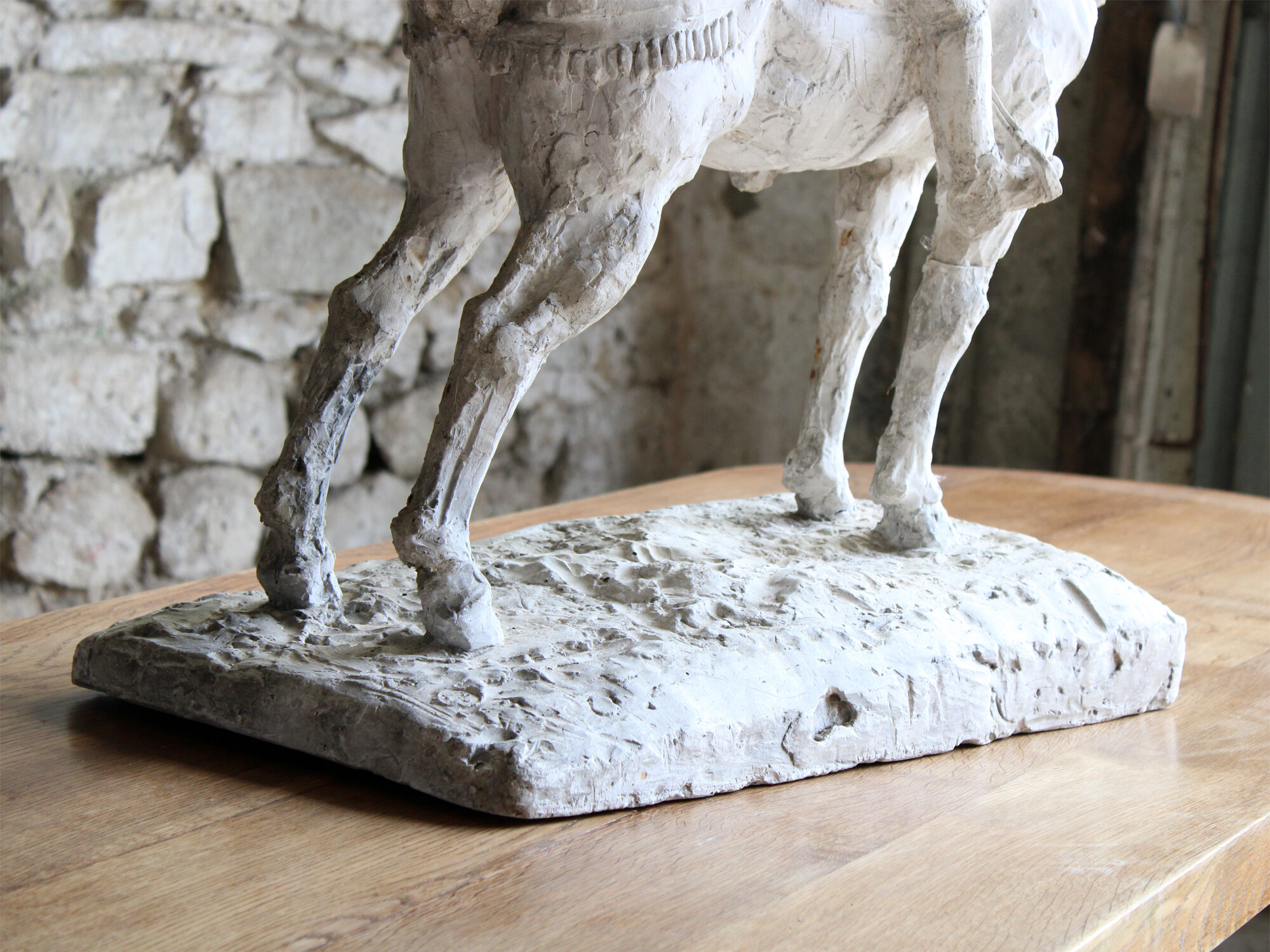
Details of our plaster model in the Modants studio.
The sculptor was constantly expanding that world. For the Alvear work, he studied Argentine horses at the Longchamps racecourse, and also carried out watercolour studies of the 20th infantry regiment’s horses when he returned to Montauban for a few months during the war. He was always looking to hone his craft, to improve his work, to enrich the matter which he kneaded into formal life.
Finally, the bronzes were exhibited at the Salon des Tuileries in 1923, and were shipped to Argentina in 1925. The work was finally inaugurated on October 16, 1926 in the presence of President Marcelo Torcuato de Alvear, grandson of the general. Bourdelle’s chevaux, with their rough impressionist surface and rough-cut and riveted panels, anticipated Deborah Butterfield’s steel and bronze horses, Kehinde Wiley’s Rumors of War, and the more modern work of Nic Fiddian Green.
PROVENANCE
The piece’s history is of considerable interest. It recently became available for sale from a private owner—an unmissable opportunity for the Modants studio. The previous owner ran a notable London art gallery until the early 1990s, and purchased the plaster from a Paris antique dealer specialising in sculpture in 1984. Unsurprisingly, given their experience and dexterity in the world of fine art, the previous owner was a connoisseur of French sculptures, as well as paintings from the Old Masters through to the early 20th century.
They had the piece assessed by various experts and institutions over the years, with a range of opinions. Frustratingly, the Mussee Bourdelle only examined the piece in 2005/6, by which time Rhodia Bourdelle, the sculptor’s daughter, had sadly died. Rhodia was one of the foremost experts on her father’s works, and she was able to definitively confirm the authenticity of various pieces. However, such reliable expertise disappeared with the loss of Rhodia. The museum was not able to say that our piece was the work of Bourdelle, but that is not the whole story.
Christie’s London was happy that the work was a plaster model of Alvear by Bourdelle, and was eager to sell the piece in an Impressionist and Modern sale. The independent expert Roland Lepic, a member of the highly respected Syndicat Français des Experts Professionnels en Œuvres d'Art et Objets de Collection (SFEP), was also confident that the work was Bourdelle’s. Perhaps most compellingly, the director of the Musee Ingres Bourdelle in Montauban, a uniquely well placed judge given the museum is in possession of the other Alvear maquettes, saw our statue and thought that it could well be by Bourdelle. Though they could not be absolutely certain, their innate feel for the work is likely to be more trustworthy than most.
SUMMARY
Ultimately, there is no wrong answer to the intriguing questions provoked by this piece. It draws the viewer in, and invites us to imagine beyond it—to the horizon of possibilities it presents. It is, on its own and on the pure level of the object, a lovely thing. Yet with context, it is even more. No metric is useful in isolation: comparative analysis often yields the most productive insights. In this case, the startling similarities between the maquettes in the Musee Ingres Bourdelle and this piece are impossible to ignore.
We know Bourdelle took years to finish his work on Alvear. We know multiple versions of the same sculpture exist with slight variations. We know it bears the hallmarks of the final work. We know multiple experts believe it to be the work of the master sculptor. Of course, there are things we don’t know. But then there is always more mystery, more of the artistic trail to explore. After all, nothing is set in stone.





